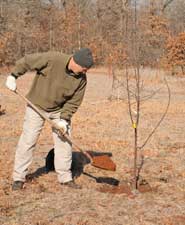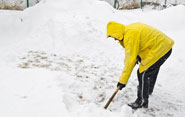7 daily habits you should change to stop hurting your back

By Sherwin Nicholson
Lifestyle & habits may be the biggest reasons to cause back pain
Let’s look at 7 of the best areas to adjust with as little stress as possible.
When people think of lower back pain and lifestyle, they first tend to think that a sedentary life is the main cause. Although it can be a leading cause, others such as diet, stress, smoking, posture, proper lifting and amount or intensity of physical activity come in to play.
Your lifestyle has a major impact, next to injury or disease of the spine. But the good news it that it is also one of the easiest areas to fix.
1. Avoid living a sedentary life
Sedentary lifestyles are never good. Especially for your body.
We are all guilty of falling into one at least more than one occasion, is sometimes it’s beyond our control. A sedentary life prevents and delays us from the needed conditioning that our bodies need to meet the demands of the day.
The strange thing about it is that at first it feels good to be sedentary, but with enough time you’ll eventually feel much worse.
Ideally, you should be feeling uncomfortable at first when sedentary and much better after you avoid it, with activity. This is the way it should be.

Teaching your core to become ‘inactive’
The moment you go into a relaxed sedentary position of sitting or lying down, your core muscles effectively shut down. THIS IS BAD!
Because the lumbar spine must bear heavy forces from our bodies, the muscles that support and protect it need daily ‘activation’ to function well.
Lack of basic exercise causes the low back to become stiff. Stiffness is usually worse in the morning while muscles can remain tight, weak, and sore for the remainder of the day. The discomfort and lack of mobility deter and discourage us from wanting to exercise these very same muscle groups that are affected.
It’s a trap that is hard to escape
If your career has you forced into a very sedentary situation, practice these tips to overcome bad work habits.
Sometimes you can fall into the trap of avoiding being active because you think you’re better off resting. However, too much rest is also known to slow down our recovery efforts and even worsen it.
It is really from lack of exercise that leads to reduced flexibility, mobility and endurance. This is a tough cycle and habit to break.
Our spines are so forgiving of the abuse that we subject it to. If you only notice slight aches and soreness from time to time, rest or over the counter medications are most likely your routine. Usually over the counter pills are adequate, and we continue with their use along with our current sedentary lives.
What we do not realize, is the amount of injury, long term damage and degeneration that can occur since we cannot observe direct damage to our spine.
By rearranging our priorities, investing much needed time to keep our backs healthy and stronger, and engaging in a spine healthy activity, we can reverse this cycle, accomplish more and enjoy more free time.
2. Creating a more active life
 Active lifestyles are certainly what we all desire for our long term health and overall fitness and fulfilment. As with a sedentary life, there is also a strong correlation with an active lifestyle and back problems.
Active lifestyles are certainly what we all desire for our long term health and overall fitness and fulfilment. As with a sedentary life, there is also a strong correlation with an active lifestyle and back problems.
Many people believe that their active lifestyle is what helps to keep them pain-free. There are also many who are active yet suffer low back pain. It can be upsetting and discouraging as they are trying to stay active yet still suffer themselves.
They experience the same challenging cycle where they believe that with routine activity, they can keep their back from hurting while avoiding any sedentary choices. This leads to lower back fatigue and possible injury if they are following an insufficient approach to care.
When we think of an active lifestyle, we must not only think of a physically active one but one that places priority on the health and safety of your lumbar spine.
All activities, including sports and exercise, can be performed safely, provided that the body has adequately been conditioned to protect the spine first. Use caution with activities in which there is little emphasis on posture, strength, and flexibility of the spine and hips.
By focusing more on protecting your spine, you can gain more power, mobility and endurance that will result in better performance and enjoyment when you are active.
3. Lifting properly

Proper lifting is essential as it requires a series of conscious steps and movements to move or carry something safely without hurting. Learning what is involved in proper lifting technique in step wise order protects the lower back and makes lifting a safer and more enjoyable task.
It takes time to develop but is very easy to learn. Over time, it becomes more effortless as the right muscles are activated and engaged naturally. Lifting technique is explained in the ‘treatment and prevention’ section.
4. Watching your posture
 Posture is key to prevention of lower back problems. It is the first requirement before engaging in any task. It affects every area of your daily life and requires a conscious effort and commitment to maintain and
Posture is key to prevention of lower back problems. It is the first requirement before engaging in any task. It affects every area of your daily life and requires a conscious effort and commitment to maintain and
develop.
It is vital that your posture is correct during activity as the lumbar spine must bear the most physical stress in virtually everything physical task done with the body. Poor posture is more common to have as correct posture can feel unnatural over time.
With discipline, it becomes easier and requires less effort over time. Posture and a sedentary life go hand in hand and work together to contribute to making the pain progressively worse.
5. Quitting smoking
Yes, even smoking has an effect on your lower back. Smokers are three times more likely to develop it than non-smokers. The nicotine in cigarettes is known to cause thickening of the walls of our blood vessels such as our arteries. The effects extend to the blood vessels that circulate the flow of blood to the muscles groups that protect the vertebrae, nerves and to a lesser extent, the discs themselves.
Progressive narrowing of the blood vessels results in less circulation of protective blood cells, oxygen, nutrients and removal of waste products. Blood supply, healing and recovery are slower and less efficient. The potential for muscle injury and damage is higher for smokers.
6. Managing stress
Stress affects everyone regardless of pain, but stress does have a physical effect on the lower back itself. Numerous professionals, institutions, books, websites and other sources of information are available to assist us with the consequences of stress on our lives.
One way in which stress can affect our lower backs is on our ability to manage our time efficiently and also use it to exercise correctly. Sometimes with what little time that we do have available. We tend to value exercise with the least priority and no longer consciously stay active, sleep, eat and maintain correct posture as well.
Another way is where stress affects our natural mental ability to relax. Here, the body becomes chronically tense and enters in preparation for a real or perceived stressful event. This generates significant muscle tightness in the lower back.
The lumbar area is very vulnerable to this condition become it is a very physically active part of our body. Muscle tightness in the lower back occurs as the body tries to stabilize the spine before the stressful event.
Stress also lowers our tolerance levels and raises our emotional response. We tend to find other ways to cope with the discomfort, either with more over the counter or prescription medication or by releasing our pent up and tense energy physically.
Existing physical stress, such as a previous injury or fatigue also exacerbates stress that is already present. We become too tired to exercise to treat ourselves. A chronic state of stress leads to chronic tightening of these muscles and minimal time and opportunity for them to relax and recover.
7. Keeping a strict but healthy diet

Diet is a very complex factor and sometimes requires professional help for it to become a valuable part of a back healthy treatment plan.
However, the most associated problem with back pain and diet is weight gain.
Extra weight places an unnecessary burden on the joints of the spine, hips, knees and feet. Extra weight stored in the midsection can cause the pelvis to tilt forward more thereby increasing anterior pelvic tilt. The tilt worsens as it causes the lumbar discs to bulge more and the support from the abdominals are limited and unconditioned. This weight causes lumbar imbalance, pinched nerves, sciatica, disc and facet joint pain.
Pain relief that is achieved with an exercise plan can be more efficient and will progress faster together with a successful diet plan.
It has been proven that by supplementing daily with magnesium, calcium and potassium, you can reduce chronic muscular pain. This applies to back muscle pain, spasms and tension.
Learn about 5 more bad habits you can stop now to protect yourself
Change your lifestyle with the following tips:
Start these ten exercises to protect your back
Stop this bad habit from hurting your back everyday
